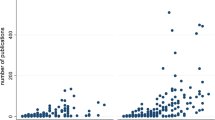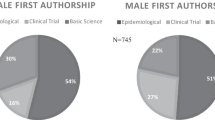Abstract
Purpose
Although women’s status has shown marked improvement over the years in many areas, women still face a gender bias, especially in the workforce. Despite the best efforts of organizations to promote diversity and equality, women still dominate the lower-paying administrative ranks while men continue to dominate at the executive level. The present study examines gender disparity in the leadership positions in the national and international endocrinology and diabetes societies across the globe.
Methods
We first composed a list of Diabetes and Endocrinology societies from online databases, including the International Diabetes Federation, European Society of Endocrinology, and other similar online directories. The Scopus database author search was used to find the total number of publications, publication range (in years), h-indices, number of citations, and years of active research of each member.
Results
Our study included 524 board members of whom 31.3% (164/524) were women. The institutional academic rank of 310 of the total board members was found. The proportion of women in higher-faculty ranks (Assistant Professor, Associate Professors, and Professors) is much lower than males. Female endocrinologists also have fewer publications, citations, and years of active research.
Conclusions
Endocrinology is becoming a female-predominant subspecialty of internal medicine. As women are becoming a more significant portion of the endocrinology workforce, it is imperative to study and mitigate gender differences and disparities to optimize the endocrinology workforce.
Similar content being viewed by others
References
M.S. Khan, M.S. Usman, T.J. Siddiqi, M.T. Ayub, K. Fatima, C. Acob, H. Muhammad, W.J. Manning, C. Tsao, F. Khosa, V. Figueredo, Cardiology: a study of program directors and division chiefs. J. Women’s Health (2018) https://doi.org/10.1089/jwh.2018.7135
R. Jagsi, E.A. Guancial, C.C. Worobey, L.E. Henault, Y. Chang, R. Starr, N.J. Tarbell, E.M. Hylek, The “gender gap” in authorship of academic medical literature—a 35-year perspective. New Engl. J. Med. 355, 281–287 (2006)
E. Pelley, A. Danoff, D.S. Cooper, C. Becker, Female physicians and the future of endocrinology. J. Clin. Endocrinol. Metab. 101, 16–22 (2016)
L.G. Hofler, M.R. Hacker, L.E. Dodge, R. Schutzberg, H.A. Ricciotti, Comparison of women in department leadership in obstetrics and gynecology with other specialties. Obstet. Gynecol. 127, 442–447 (2016)
A.H. Calderwood, B.K. Enestvedt, R. DeVivo, C.M. Schmitt, Impact of gender on requests for ASGE leadership assignments. Am. J. Neuroradiol. 83, 730–733 (2016)
A. Shah, S. Jalal, F. Khosa, Influences for gender disparity in dermatology in North America. Int. J. Dermatol. 57, 171–176 (2018)
M. Ahmadi, K. Khurshid, P.C. Sanelli, S. Jalal, T. Chahal, A. Norbash, S. Nicolaou, M. Castillo, F. Khosa, Influences for gender disparity in academic neuroradiology. Am. J. Neuroradiol. 39, 18–23 (2018)
B.J. Tesch, H.M. Wood, A.L. Helwig, A.B. Nattinger, Promotion of women physicians in academic medicine. Glass ceiling or sticky floor? J. Am. Med. Assoc. 273, 1022–1025 (1995)
A.L. Wright, L.A. Schwindt, T.L. Bassford, V.F. Reyna, C.M. Shisslak, P.A. St Germain, K.L. Reed, Gender differences in academic advancement: patterns, causes, and potential solutions in one U.S. college of medicine. Acad. Med. 78, 500–508 (2003)
M.J. Yedidia, J. Bickel, Why aren’t there more women leaders in academic medicine? the views of clinical department chairs. Acad. Med. 76, 453–465 (2001)
M. Asghar, M.S. Usman, R. Aibani, H.T. Ansari, T.J. Siddiqi, K. Fatima, M.S. Khan, V.M. Figueredo, Sex differences in authorship of academic cardiology literature over the last 2 decades. J. Am. Coll. Cardiol. 72, 681–685 (2018)
J. Bickel, D. Wara, B.F. Atkinson, L.S. Cohen, M. Dunn, S. Hostler, T.R. Johnson, P. Morahan, A.H. Rubenstein, G.F. Sheldon, E. Stokes, Increasing women’s leadership in academic medicine: report of the AAMC Project Implementation Committee. Acad. Med. 77, 1043–1061 (2002)
R. Sege, L. Nykiel-Bub, S. Selk, Sex differences in institutional support for junior biomedical researchers. J. Am. Med. Assoc. 314, 1175–1177 (2015)
P.L. Carr, A.S. Ash, R.H. Friedman, L. Szalacha, R.C. Barnett, A. Palepu, M.M. Moskowitz, Faculty perceptions of gender discrimination and sexual harassment in academic medicine. Ann. Intern. Med. 132, 889–896 (2000)
A. Poppas, J. Cummings, S. Dorbala, P.S. Douglas, E. Foster, M.C. Limacher, Survey results: a decade of change in professional life in cardiology: a 2008 report of the ACC women in cardiology council. J. Am. Coll. Cardiol. 52, 2215–2226 (2008)
M. Carnes, C. Bland, Viewpoint: a challenge to academic health centers and the National Institutes of Health to prevent unintended gender bias in the selection of clinical and translational science award leaders. Acad. Med. 82, 202–206 (2007)
R.E. Steinpreis, K.A. Anders, D. Ritzke, The impact of gender on the review of the curricula vitae of job applicants and tenure candidates: a national empirical study. Sex Roles 41, 509–528 (1999)
B.B. Fischer, M. Stamm, C. Buddeberg, G. Bauer, O. Hämmig, M. Knecht, R. Klaghofer, The impact of gender and parenthood on physicians’ careers—professional and personal situation seven years after graduation. BMC Health Serv. Res. 10, 40 (2010)
A.P. Mayer, J.E. Blair, M.G. Ko, S.N. Hayes, Y.H. Chang, S.L. Caubet, J.A. Files, Gender distribution of U.S. medical school faculty by academic track type. Acad. Med. 89, 312–317 (2014)
Acknowledgements
The authors are thankful to the endocrinology and diabetes societies, whose publicly available data made this study possible.
Author information
Authors and Affiliations
Corresponding author
Ethics declarations
Conflict of interest
The authors declare that they have no conflict of interest.
Additional information
Publisher’s note: Springer Nature remains neutral with regard to jurisdictional claims in published maps and institutional affiliations.
Supplementary information
Rights and permissions
About this article
Cite this article
Waseem, Y., Mahmood, S., Siddiqi, R. et al. Gender differences amongst board members of endocrinology and diabetes societies. Endocrine 64, 496–499 (2019). https://doi.org/10.1007/s12020-019-01861-9
Received:
Accepted:
Published:
Issue Date:
DOI: https://doi.org/10.1007/s12020-019-01861-9




